Published
on 17
Aug 2023
|
All rights reserved.
|
|
|
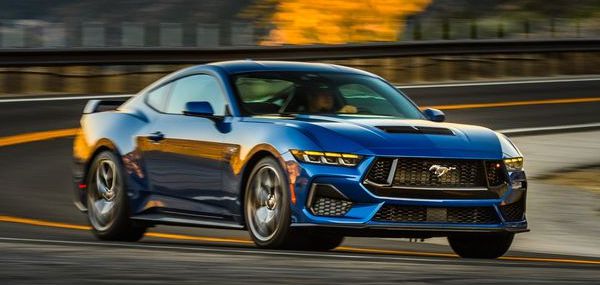 |
|
S650
just might be the last Mustang as we used to know...
|
|
Ford
Mustang was launched in 1964 as the America’s first “pony car”. Nearly
60 years later, the 7th generation was born. While the last generation
was genuinely an all-new development and went on sale globally for the
first time, the new one is only a mild development from that car. The
reasons are simple: insufficient sales volume and limited prospect.
Sales of Mustang has been declining slowly and steadily since 2015,
especially in its home market where it lost pony car crown to the aging
Dodge Challenger in the last couple of years. While overseas sales
compensates a little, it accounts for only 22 percent of all sales last
year, which totaled just over 60,000 units. Whether that kind of sales
volume supports an all-new development is questionable.
Ford’s product strategy doesn’t help either. It is aggressively
shifting towards electrification and an all-truck portfolio. The
Mustang is the only car left in Blue Oval’s American showrooms – and
globally too when Focus hatchback ends production in 2025. It makes not
much sense to develop a brand-new platform for solely Mustang. That’s
why Dearborn would rather keep updating the existing one.
In fact, with the Mustang nameplate already expanded to Mach-E, you
don’t need a crystal ball to foresee the next generation Mustang, if it
does survive, will be turned to electric. It won’t be the Mustang as we
used to know in the last 60 years. That’s why you’d better to take the
last chance to enjoy it.
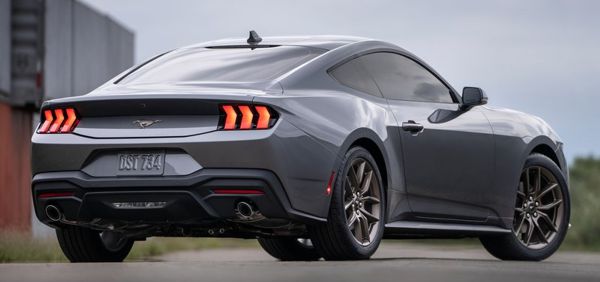 |
|
Base
Mustang still sells for value for money.
|
|
As all hardpoints and windows are carried over, no wonder the new
Mustang looks so familiar. Still, the new sheet metal is sharper,
crisper and better looking. Ditto the more sophisticated-looking
headlights and reshaped grilles.
Bigger news is the interior. While seats, door cards and transmission
tunnel are much the same as before, the dashboard and console are
overhauled. “Dual-cockpit” design is sacrificed for a modern flat panel
display that houses a 12.3-inch instrument and a 13.2-inch
touchscreen. This means gauge graphics are configurable. The
infotainment system is responsive and smartphone connectivity is
straightforward, but on the downside the touchscreen replaces physical
buttons for climate control and audio, making it more difficult to
adjust on the move. Quality of materials is improved slightly, but
there are still plenty of cheap plastics at touch points, because the
base Mustang still sells for little money.
Yes, the 4-cylinder model starts from $33,000 at its home market, which
is still pretty good value considering the power and amount of steel
you get. Upgrade to V8 GT – you should, if you can afford – will demand
at least $44K, which undercuts a Civic Type R slightly.
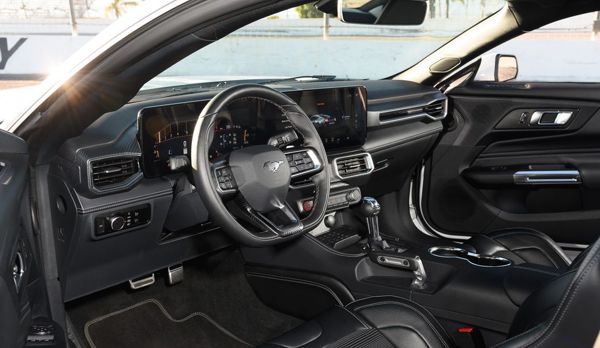 |
|
Besides
a Toyota Supra, BMW M240i or even a Chevy Camaro, it feels bulky and
nose-heavy, more prone to understeer.
|
|
The 2.3-liter Ecoboost engine is largely carried over, barely improved
by 5 horsepower. Ford said it uses a new turbo setup and introduces
dual-mode injection system to improve efficiency and refinement, which
barely shows in EPA numbers. It’s still not a romantic engine in terms
of sound and power delivery, which concentrates in mid-range.
Performance should be more or less the same as before, i.e. 0-60 mph is
achieved in the low 5-second range. Sadly, manual gearbox is no longer
available to the Ecoboost engine, as Ford said its take rate was
extremely low in the last generation. This means a 10-speed auto is now
the mandatory choice. It’s fine for normal driving, but nothing
remarkable.
Meanwhile, the 5.0-liter Coyote V8 is lightly improved from the old
one. It gets dual-mode injection, too, as well as a dual throttle body
for enhanced breathing. Output increases by 20 ponies to 480
horsepower, released at a slightly higher 7250 rpm, though peak torque
dips by 2 pound-foot to 418. Opt for active exhaust will add another 6
horsepower to the top end.
Needless to say, the V8 is much more enjoyable than the four-cylinder.
It is not terribly torquey low-down, but the power delivery is linear
and smooth, and the way its tone changes from deep rumble to a sharp
edge howl at the top end is quite exciting. 0-60 mph sprint should be
done in just over 4 seconds, very competitive for what it costs. The V8
works with either a 10-speed auto or a Getrag 6-speed manual. Both do
the job reasonably well without being distinctive.
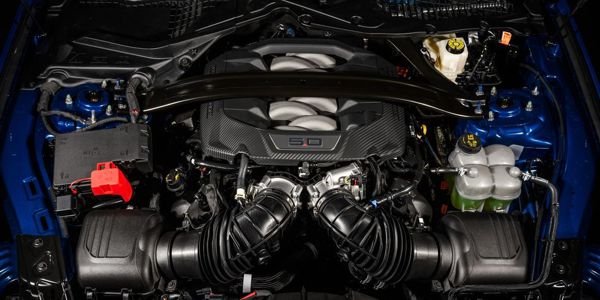 |
|
The
way its tone changes from deep rumble to a sharp edge howl at the top
end is quite exciting.
|
|
On the chassis side, modifications are equally limited. The body is
said to be stiffened at certain places, but improvement to rigidity is
too little to mention. The suspension is retuned, and the front control
arms become aluminum. The steering rack gets stiffer mounting to
improve precision and feel, while steering ratio is quickened slightly.
Besides, a Performance package is available for $5,000. It adds goodies
like Torsen LSD, Brembo brakes, Pirelli P Zero rubbers, stiffer front
springs, thicker rear anti-roll bar, a shorter final drive ratio, a
strut tower bar and a larger rear spoiler. Another $1,750 will get the
optional magnetorheological adaptive dampers.
With all these goodies added, the Mustang does drive better than
before. The ride is noticeably calmer on broken surfaces. The body
control seems slightly better, and the steering feels slightly sharper.
However, no matter the Ecoboost or GT, the Mustang is a big and heavy
car. Besides a Toyota Supra, BMW M240i or even a Chevy Camaro, it feels
bulky and nose-heavy, more prone to understeer. You need to cope with
its weight, braking earlier and turning slower in corner. The steering
is also disappointingly numb besides those true driver’s cars. The most
valuable asset is still V8 power, which is increasingly rare these
days, especially after the extinction of Camaro and Challenger next
year.
Is the Mk7 Mustang disappointing? If you expect a new generation, yes.
If you expect an extension of an aging model, then probably not.
However, it seems to me that
Ford deliberately holds the best for pricier versions, starting from
the Dark Horse (see below). This leaves the Ecoboost and GT
modest roles to fill, serving less enthusiastic drivers at reasonable
costs. Among them, the GT is still worth recommended. Although handling
is nothing memorable, its V8 motor puts smiles on your face, makes you
feel proud and special, just like what the legendary pony car shone
over the years.
|
Verdict:
   2.3 Ecoboost
2.3 Ecoboost
    5.0 GT
5.0 GT
|
Published
on 17
Aug 2023
|
All rights reserved.
|
|
Mustang Dark Horse
|
|
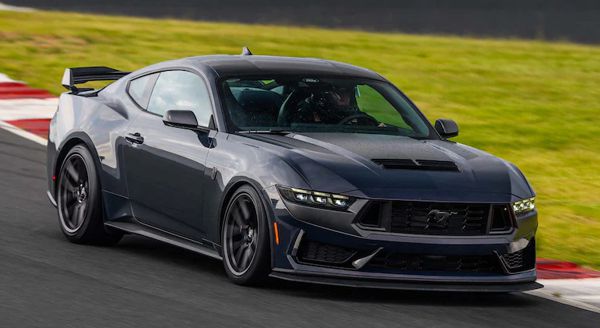 |
|
Dark
Horse extends the line of Boss 302, Bullitt and Mach 1, which is a
slightly faster and more track-friendly Mustang.
|
|
Dark
Horse is a new nameplate, but its position in the Mustang’s family tree
is just the same as the previous Mach 1, Bullitt and Boss 302, i.e. a
slightly faster and more track-friendly Mustang. The car is priced at
$61,000 in its home market, pretty good value for money considering its
extra equipment over the standard GT, such as MagneRide adaptive
dampers, larger Brembo brakes, P Zero tires, Torsen LSD, oil coolers
for engine, transmission and differential. This means all you need is
the $5000 Handling package, which adds a larger rear spoiler, stiffer
springs, larger anti-roll bars, more negative camber and a set of very
wide Pirelli Trofeo RS tires.
The V8 engine is tuned further, achieving a full 500 horsepower or 100
horsepower per liter. It gets forged steel crankshaft and con-rods from
the last GT500 to withstand the higher stress. The 6-speed manual is
also different from the standard GT. Whereas the latter employs a
Getrag unit, the Dark Horse uses Tremec TR-3160 like the last
generation GT350 and Mach 1, whose gearshifts are more precise and feel
more mechanical. Ford’s inhouse 10-speed automatic is still an option,
but you should get the manual for pure driving satisfaction, especially
when its titanium gear knob looks and feels so cool.
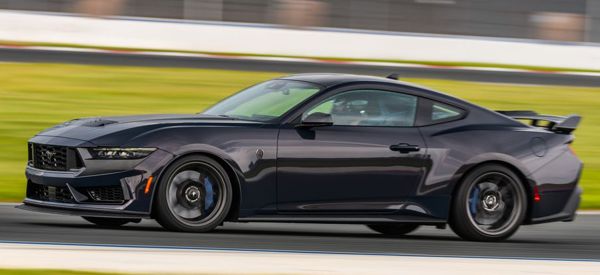 |
|
The
Dark Horse feels rock solid in corner.
|
|
In dark color, the Dark Horse with Handling pack looks quite cool. Its
Trofeo RS rubbers – a massive 50mm wider up front and 40mm wider at the
rear than those on the GT – fill the wheel wells better. These tires
offer massive grip, transform the car’s handling and lift its cornering
prowess massively. The Dark Horse feels rock solid in corner. Stability
is maintained under heavy braking. Body control is also improved. It is
nicely balanced and predictable on track. In short, an entertaining car
for track days.
Having said that, the heft of the car can still be felt in direction
change or under braking, blame to the weight at its nose. A Camaro 1LE
feels sharper and more agile. Ditto the new BMW M2, which rests in the
same price bracket.
On road, the magnetorheological adaptive suspension works flawlessly to
smoothen bumps, making the car surprisingly livable for what is
supposed to be a part-time track car. The extra grip offered by Trofeo
RS tires is way more than required in any circumstances, so much that
its handling could feel a little dull. You will notice the car’s width
on narrower backroads, and the steering is disappointingly numb,
failing to communicate with the front wheels as a great driver’s car
should.
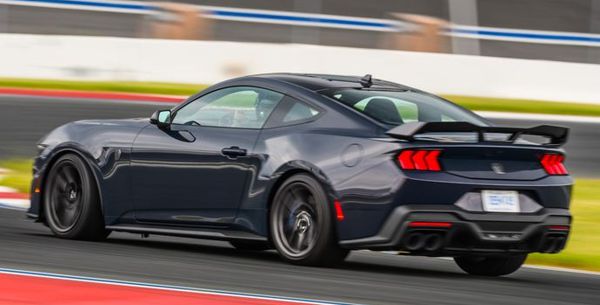 |
|
Massive
Trofeo RS rubbers transform its handling.
|
|
The Coyote V8 on Dark Horse is not terribly different from that of the
GT. It feels a little livelier at the top end and a little angrier in
its vocal, but its character barely changes. Smooth, linear and
flexible power delivery is still its trump card. Is it really quicker
than the GT on a straight? I doubt, considering the advantage of only
14 horsepower offset by several dozens extra kilograms. However, thanks
to those massive tires and enhanced chassis, lap time is day and night
difference.
A new GT350 with high-revving V8 is still on the top of our wish list,
but before that happens, the Dark Horse is the closest thing. It might
not be
as fun to drive as the Camaro 1LE, but it is a more modern car and a
more rounded package.
|
Verdict:    
|
|